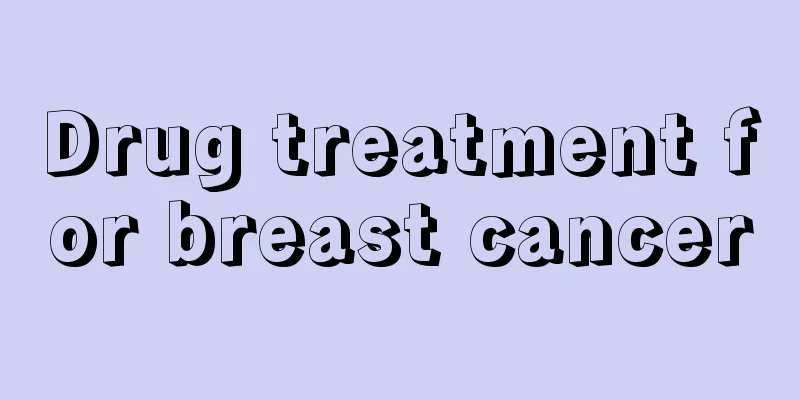Drug treatment for breast cancer

|
The incidence of breast cancer continues to rise, and it has become the first or second most common malignant tumor in women in my country. Although there have been significant improvements in treatment, many patients still die from metastasis, which is the main reason for the failure of treatment. The most effective way to solve this problem is to develop and produce more chemotherapy drugs with high efficacy and low toxicity. We hope that the pharmaceutical industry will make greater contributions in this regard in the new century. The main treatments for breast cancer include surgery, chemotherapy, radiotherapy, and biological therapy. The clinician must choose different methods in combination according to the early or late stage of the disease. When the selection is reasonable, the effect is better than a single method. Among various cancers, breast cancer is a tumor that is relatively sensitive to anticancer drugs. Therefore, chemotherapy has always played an important role in the comprehensive treatment of breast cancer. For most surgical patients, chemotherapy can be used before or after surgery. For those with advanced metastasis and spread, chemotherapy is the main method. If chemotherapy is used, the choice of drugs is of course the key. After decades of research, more than 20 relatively effective drugs have been confirmed, among which the highly effective drugs with an efficacy of about 50% include doxorubicin (doxorubicin, epirubicin, bilirubin), paclitaxel (paclitaxel, taxol, taxotere, paclitaxel), and novelbine. Moderately effective drugs with an efficacy of 20-50% include cisplatin, cyclophosphamide, fluorouracil, methotrexate, mitomycin, thiotepa, vincristine, etc. In addition, there are carmustine and cyclohexyl nitrosourea, which have a lower efficacy but can enter the brain to treat brain metastases. Studies have shown that the effect of rationally selecting several drugs combined with chemotherapy is significantly better than single drug treatment, but combined drug use should follow the following principles: 1. Each drug must be effective when used alone; 2. The action points of several drugs should be at different times during the process of cancer cell division and proliferation; 3. Choose drugs with different toxicity types to avoid overlapping and cumulative toxicity; 4. Choose a plan that has been proven to be effective through long-term clinical application research. According to the above principles of combined medication, there are currently two types of regimens that are recognized to have higher efficacy at home and abroad: 1. CAF (adriamycin, cyclophosphamide, fluorouracil) regimen, with an effective rate of 50% to 75%; 2.CMF (methotrexate, cyclophosphamide, fluorouracil) regimen, with an efficacy of 60 to 69 percent. The former has a higher efficacy, but doxorubicin has a greater toxicity to the heart. The second-generation epirubicin has significantly lower toxicity, but the price is too high. Although the CMF regimen has a slightly lower efficacy, it is still a better regimen among the many regimens for treating breast cancer, and it has less toxicity. At present, based on my country's national conditions, it is often used in early clinical cases or cases with less than 3 axillary lymph node metastases found in postoperative pathological biopsy. For patients with tumors larger than 5cm or severe axillary lymph node metastases in stage II or III before surgery, or patients in the middle and late stages with more than 4 axillary lymph node metastases found in postoperative pathological examination, it is often advocated to use regimens containing doxorubicin. Of course, there are many other regimens with efficacy similar to the above two, but they are far less commonly used than the first two. It is also worth mentioning that the research on anticancer drugs is progressing rapidly, and new drugs with higher efficacy and lower toxicity are constantly emerging. For example, paclitaxel and navelbine mentioned above have shown encouraging good short-term efficacy. In recent years, their clinical application has gradually increased, but after all, the application time is short, and whether the long-term efficacy of more than 5 years is better than the above-mentioned scheme remains to be verified. Moreover, it is expensive, costing thousands or even tens of thousands of yuan per month, so it is currently mostly used as a second-line drug for cases that are resistant to first-line drugs, or in advanced stages and have metastasized and spread, and is often used in combination with the long-tested adriamycin class to improve long-term efficacy. It is also worth mentioning that breast cancer is closely related to ovarian function, mainly the estrogen secreted by the ovaries. Estrogen in the patient's body often stimulates or promotes the progression of cancer cells, especially when cancer cells contain receptors that can bind to estrogen, they are more susceptible to the effects of estrogen. Studies have found that more than half of breast cancer patients contain such receptors. If the receptors are prevented from binding to estrogen, the cancer cells that have no hormones to rely on will slow down their growth or even shrink. Therefore, clinically, patients with positive estrogen receptors are given corresponding drugs to prevent the combination of the two. This therapy plays an important role in the endocrine treatment of breast cancer and can indeed achieve considerable therapeutic effects. It has been widely used in the treatment of receptor-positive breast cancer at all stages. The representative drug of this therapy is tamoxifen, which has an efficacy of more than 60% for receptor-positive patients. Moreover, for those who are effective, if the drug fails after long-term use, second- and third-line drugs have been developed to replace it and continue to exert a certain efficacy. |
<<: Skin care after radiotherapy for breast cancer
>>: Can swelling after breast cancer surgery be cured?
Recommend
How long can a child live with brain cancer
Brain tumors can occur in people of any age, and ...
There is a muscle pain on one side of my head
The human brain nerves are very sensitive and wil...
The efficacy of garnet
Garnet is a very common gemstone. Garnet has many...
Identification of live and dead scallops
When we choose scallops, we will find that the pr...
Treatment of hormone allergy
Although many drugs can achieve certain therapeut...
Can I eat fish after getting a face-lift injection?
Face-slimming injections are taken by many female...
What are the effects and contraindications of adenosine monophosphate?
For many people, injecting adenosine monophosphat...
What is the difference between skin cancer and skin tumor
I believe that people know more about skin tumors...
Is tinea cruris contagious
Ringworm can appear on many parts of the body. We...
Is it okay to wash your hair in the morning? The problem is so serious
Many people who love beauty have developed the ha...
What foods are good for liver cancer? Eat these foods if you have liver cancer
With the development and progress of society, can...
How to distinguish between yang deficiency and yin deficiency in the body?
From the perspective of traditional Chinese medic...
What are the causes of primary liver cancer? Six reasons can lead to primary liver cancer
What are the causes of primary liver cancer? This...
At what point does the lung detoxify?
The lungs are very important respiratory organs i...
What are the treatment methods for lumbar disc herniation?
Lumbar disc herniation is a very common spinal di...









